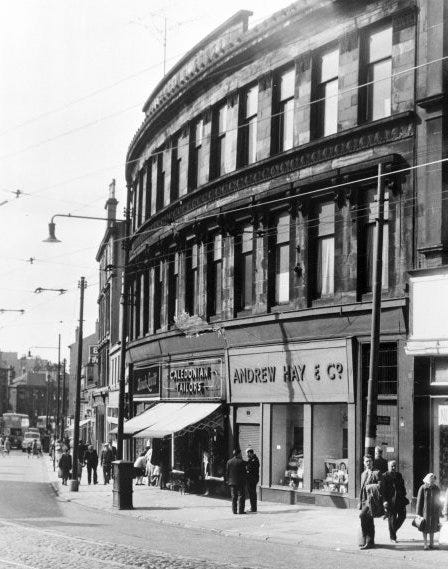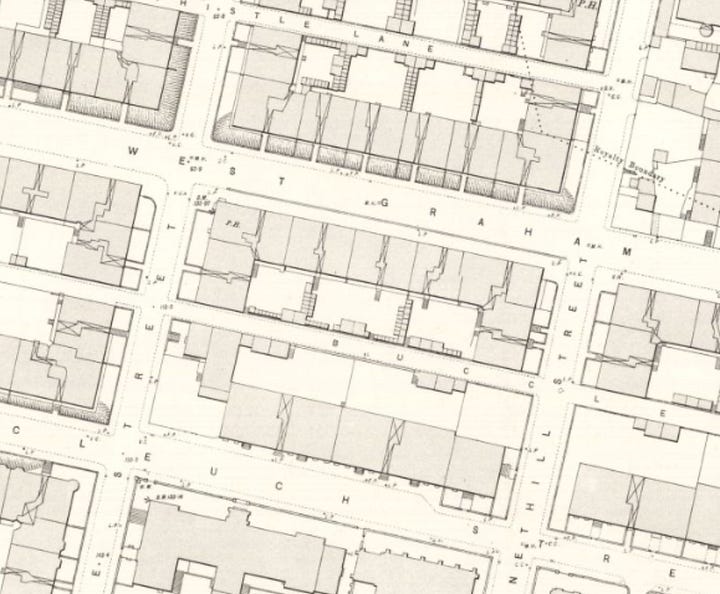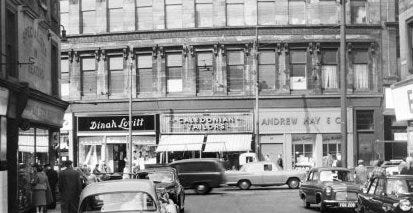Thomson's Cowcaddens Cross building: from Copland's in Glasgow to Gilchrist's in Boston
After early bankruptcy, how a pair of builders struck lucky
Updated with images, September 2023

In 1872, ‘Greek’ Thomson’s Cowcaddens Cross building, at 110-120 Cowcaddens Street, Glasgow (above) began construction. This comprised spaces for shops on the ground floor and warehousing above. The site was on a shallow curve and appears to have involved a ground-floor masonry facade over a cast iron frame. The work was in progress in early 1873 and completed by June1.


Photographs of the building, of which there are few, can be seen here and here. It was demolished in 1971 as part of the wider Cowcaddens redevelopment.
This was a time when much of Thomson’s work in Glasgow was on hold, as he wrote to his brother George, who was now engaged on the ‘merchant-missionary’ work in Cameroon:
‘A good deal of the work in which I am engaged when I last wrote to you has been laid aside for the present in consequence of the unpresidentidly [sic] high prices in all departments of the building trades - Iron pillars are 12/- or 13/- per cwt Bricks 40/- per tn coals 30/- pr ton.
‘The Jardine’s bought an old property in Cowcaddens opposite the end of Findlay Street 93 ft frontage and are building it to my plans. It is for shops and warehouses and they are asking and likely to get large rents - They paid 8/- per yd for the ground’2.
The Jardine family
The Jardines were a long-established family of masons, originally from Dumfries-shire, where James Jardine was born around 1798 in Closeburn. He married Mary Hyslop from the same county and had five sons and two daughters. The sons all survived to adulthood and became masons, and the two daughters may well have survived as well into adulthood, although what happened to them isn’t known. All were born in Dumfries-shire, except for the youngest son, Adam, who was born in Kirkcudbrightshire and the younger daughter, Ann, who was born in 1842 in Glasgow (the family had relocated there at least by the previous year, living in Keppochill, to the north of the city).
The Jardines involved in the Cowcaddens project were James (1825-1881) and Joseph (1830-1906), the first and fourth sons. They had established ‘J. & J. Jardine, masons’ at 33 North Woodside Road, to the west of the city, by 1856, but by the following year were based at Mount Pleasant Cottage, Grant Street, St George's Road (There were several cottages along St George’s Road at this time; they would later largely be replaced by four-storey tenements). James himself lived at 19 Shamrock Street. By the middle of 1861, the business had moved to 82 Scott Street, Garnethill, closer to the city centre, while one or both brothers and their families had moved to 37 Arlington Street, still in the West End.
The earlier we know of their business is from 1860, when they applied to the Glasgow Dean of Guild Court for permission to build in the Garnethill area: 'Messrs. J & J. Jardine, builders, Glasgow, to erect buildings in Thistle, West Graham, and Garnet Hill Streets'3. The site comprised the northern half of a block that was empty in 1857, despite being within walking distance of the city centre. By 1895, the area had been entirely filled in, mostly with tenement flats4.


Whatever the Jardine brothers constructed has since been demolished, although the block at the corner of West Graham Street and Thistle Street can be seen at image No. 37 here. Initially, the block seems to have been called Lilybank Terrace, although that soon disappeared. There are no evident advertisements for selling or letting the apartments, although by late 1862, at least some must have been occupied5. Still, however fast they were sold or were rented, James and Joseph Jardine found themselves in trouble, with the appearance of the following newspaper entry: 'Scotch Bankrupts: J. & J. Jardine, builders in Glasgow'6.
Bankruptcy, then as now, does not mean that the person or persons made bankrupt cannot recover. What often seems to have happened in the mid-to-late 19th century is that creditors received a proportion of what they were owed, which might be 25 per cent (5s. in the £), plus a promise to repay all or most of the balance over time. The brothers’ bankruptcy came too late to stop the name of ‘J. & J. Jardine, masons’ appearing in the 1862 Glasgow Post Office Directory. The company was now based at 126 West Graham Street, facing the tenement they had probably completed (typically, such projects took eighteen months or less from planning permission to completion), they were in a good position to complete any snagging, collect rents and assist new enquirers. A decade later, with a wife and eight surviving children (one had already died, aged 12), James had moved slightly further east, to 108 West Graham Street, next to Stow College.
Before the bankruptcy, Joseph Jardine had moved to 271 North Woodside Road and remained there for at least a decade. By now, all the other brothers had married and were raising families, although Joseph held out until 1866 before marrying Margaret Gilchrist (1830-1892). Margaret’s sister Jane had married another John Jardine (c. 1828-1902) from Dumfries-shire, a cousin of Joseph’s family.
At the time of his 1861 marriage, this second John Jardine was living at 39 North Woodside Road, two doors along from where the first Jardine family had lived. His family came from Closeburn, Dumfries-shire, and John was a mason’s clerk, possibly working with his mason cousins, before ultimately becoming a house factor and insurance agent (his death was witnessed by Marion Jardine, James’ daughter, listed as a ‘second cousin’, suggesting that, half a century after arriving in Glasgow, the various relations remained in touch with one another).
In the 1861 Census, five years before her own marriage, Margaret Gilchrist was listed as a ‘Domestic servant’, living at 80 Scott Street with her sister and her husband, John Jardine. She presumably helped her sister keep house, which in 1861 included two infant children and three male lodgers: a customs officer, a pupil teacher and a medical student.
By 1871, Joseph Jardine, his wife Margaret and a four-year-old daughter, Margaret Haining (‘Maggie’) Jardine, lived at 94 Thistle Street, a short distance from the tenement block he and his brother had constructed a decade before. Whatever work he and John had carried out in the years since their bankruptcy, whether on their own behalf or for others, they clearly had enough resources to be able to buy the plot at 110-120 Cowcaddens Street to construct a new set of shops and offices by ‘Greek’ Thomson, by now a well-known Glasgow architect.
The Thomson connection
Where did the connection between the Jardine family and Alexander Thomson come about? The Jardines may have worked as masons on the various other buildings Thomson had designed. In 1871, he had four quite different projects underway: a stand-alone villa, Ellisland, at Nithsdale Road in Pollokshields on the south of the river; Westbourne Terrace in the West End; an extension to Blackie's Printing Works at Stanhope Street, to the north of the city centre; and Egyptian Halls, at the city’s heart in Union Street.
Another route may have been via Robert Turnbull, soon to become ‘Greek’ Thomson’s business partner, following the departure to Africa of his brother George, to whom Alexander wrote regularly. Turnbull would not become Thomson’s partner until 1873, but he is listed as one of James Jardine’s trustees following the latter’s death in 1881. James’s will was drawn up in September 1875, five months after Thomson’s death. There is no evidence so far of the Jardines undertaking further work for Thomson or Turnbull, although they may have done so. Could the relationship between the Jardines and Turnbull predate the latter’s business involvement with Thomson, or did it arise from the Cowcaddens Cross building?
Cowcaddens Cross

As for the building itself (above), it is one of only two examples of Thomson designing for a convex curve, assuming the Garnkirk showroom at the top of Buchanan Street was the other (the challenges of Glasgow street numbering mean that precise location is unclear), and his 1857 Walmer Terrace is concave.
As Thomson wrote in 1872, the Jardines were keen to obtain a decent return for their investment, and one way to do this was to keep the internal arrangements as flexible as possible. Therefore, instead of constructing solid walls and pre-determining the size of individual shop units, the Jardines asked for the shops (and presumably the upper warehouse spaces as well) to be separated by wooden partitions, able to be moved as their lessees’ requirements changed. This was to prove a fortunate decision.
The premises had not been completed by mid-1872 when the Glasgow Post Office Directory for 1872-73 appeared. By the following year, only hat manufacturer John F Hanbidge & Co. was in occupation, at No. 118, and the Jardines were advertising ‘Flat to Let, at Cowcaddens Cross, opposite foot of Findlay Street. Very suitable for one or two Halls. Apply to W. J. Easton, 150 Regent Street, or to Messrs. Jardine, 71 Park Road'7. The Jardines struck lucky, for in August 1873, naming the building ‘Caledonian House’, the drapery partnership of Copland & Lye opened at Nos. 110-112.
Initially, William Copland and John Lye employed a staff of 20; by 1874, they had taken over No. 114, and No.116 by 1875, expanding to occupy the whole building by early 1877, now with a staff of 1508. Extensive advertising and regular promotions were essential ingredients of their success and being able to extend their premises by removing the internal partitions no doubt made for low-cost expansion.
By 1877, however, Copland & Lye had outgrown the building and begun constructing a new store on the more fashionable Sauchiehall Street. A Grand Removal Sale was announced in November 1877, with the intention of relocating ‘early in the New Year’9, although the new store did not open until 4 May 1878. Meantime, the Grand Removal Sale continued, and the new building, to which the name 'Caledonian House' was transferred, began its life with an equally grand Opening Sale. The partnership would just over a decade, ending with Copland’s death in 1884, and with Lye as sole owner until his death in 1889.
The Jardines never found a tenant to match. The connection to Robert Turnbull remained, however, with the practice given responsibility for seeking out new tenants. Over the following 15 years, advertisements appeared under their name: ‘Cowcaddens Cross.-Spacious Shops and Warehouses to Let in Centre of Cowcaddens (opposite Finlay [sic] Street). Will be Altered or Divided to suit Tenants. Rents Moderate. Apply to A. [sic] Thomson and Turnbull, Architects, 122 Wellington-street'10.
The Gilchrist connection
Jane and Margaret Gilchrist, who had married John and Joseph Jardine respectively, came from a large Dumfries-shire family, with the children born in Thornhill11 or Penport. Their father, Charles, was an agricultural labourer, and seems to have remained in the county throughout his working life.
Their mother, Margaret Haining (sometimes ‘Hanning’) came from Dunscore, also in Dumfries-shire, and the children - five sons and seven daughters - spent much of their childhood in one or more of ‘Tibber’s Cottages’ in Penport, part of the estates of the Duke of Buccleuch.
The eldest son, Robert (1836-1893) left Dumfries-shire around mid-1851 and headed for Glasgow. Aged 14, he found employment in the drapery store of Arnott, Cannock & Co.12, but four years later emigrated to Boston, Massachusetts. Here he found employment in another drapery store, and by 1861 had been enticed to join another, George Turnbull & Co., of Winter Street, as a clerk.
George Turnbull was another Scot, but from the Highlands, who had arrived in Boston in 1841 aged 24 at the urging of his brother, who was the minister at Harvard Street Baptist Church. By the end of the following year, he had opened 'George Turnbull, dry goods', at Washington Street. Four years later, he took in David M Kinmouth as a partner, establishing George Turnbull & Co. In 1854, the firm expanded and moved to nearby Winter Street at Nos. 5 and 7. The store would remain there for the rest of its existence. Kinmouth left the partnership, being replaced by William W Churchill. In 1865, Turnbull retired from the business, which was now named Churchill, Watson & Co., and with Robert Gilchrist taken on as a partner (presumably with some financial investment. Robert must have done well and saved hard: in the 1860 US Census he stated that he owned real estate worth $8,000 and had a personal estate of $11,000). By 1873, the firm was named Churchill, Gilchrist & Smith.
Four years later, in 1877, Robert was joined in Boston by his youngest brother John (1851-1901). Together they formed R. & J. Gilchrist, but with another partner whose name was not included in the company title, James Jardine.
While Robert Gilchrist’s involvement in drapery (‘dry goods’ in the US) pre-dated the success of Copland and Lye, it seems likely that James’s involvement recognised the profits to be made in the trade, spurred on by the income from Copland’s having taken over the whole Cowcaddens Cross building and reinforced by Robert Gilchrist’s own success.
Nor were the Gilchrist brothers the only Scots to succeed in the dry goods market: John E. Troup was from Old Meldrum, Aberdeenshire, arriving in Boston in 1855 and being taken on by George Turnbull so he would have worked alongside Robert Gilchrist. A year after Turnbull’s retirement, he, together with John McAuslan from Argyll, who had arrived in Boston in 1858, and Walter Callender, opened a dry goods business in Providence, Rhode Island, that, as Callender, McAuslan and Troup, became the state’s leading dry goods emporium13.
Gilchrist’s, as it became generally known, prospered, employing the first female sales clerk in the USA and taking over adjacent sites until in 1912 it constructed a ten-storey block that remains today, although Gilchrist’s itself closed in 1977.
The Jardines, afterwards
Back in Glasgow, a year after completing the Cowcaddens Cross building, James and Joseph would obtain their Burgess Tickets in the Incorporation of Masons as 'far hands' (that is, applicants with no previous connection to the Incorporation).
By 1881, James had moved with his family to Park Road in the west of the city, but in the coastal town of Rothesay, he suffered a heart attack: 'Last Sunday morning, Mr James Jardine, builder, Glasgow, died suddenly in his lodgings, Montague Street. Dr Hunter was immediately called, but death had already ensued from apoplexy. Deceased was about 56 years of age'14.
The value of his holdings in J. & J. Jardine were calculated at £7,623.1.4 (£742,000 today), and his shares in ‘Messrs R. & J. Gilchrist, drapers of Boston’, were worth £4,204.15.7 (£409,000 today).
James’s next brother, John Jardine, a mason throughout his working life, died in 1901; the third, Alexander, a foreman mason at the time of his death, died from tuberculosis in July 1872, as the Cowcaddens Cross building was being completed. Adam, the youngest brother, also a mason, died from pneumonia in January 1873, at the age of 37. Alexander’s son, William (1864-1927) emigrated to Boston at the age of 20, joined the firm and rose to become Vice-President of the Gilchrist Company, and of the Cowman Cooperative Bank of Dorchester.
Joseph died in 1906, having retired to Cambuslang, outside Glasgow. His estate included various IOUs from family members, income from properties in Park Road, West Princes Street and North Woodside Road, all in Glasgow’s West End, and a 50 per cent share in rents from the Cowcaddens Cross building. He also held shares worth $3,400 in R. & J. Gilchrist. In all, his estate came to £4,219.14.11 (£410,000 today).
Family trees for the families mentioned in this article can be found in the Combination Tree on Ancestry.com (those known or believed to be living are not shown)
Glasgow Herald, 6 Jan 1873, Glasgow Herald, 18 June 1873
Alexander Thomson to George Thomson, 20 Sep 1872
Glasgow Herald, 14 Dec 1860
By the 1950s, the block numbering was 55-57 Garnethill Street, 103-125 West Graham Street, and 90 Garnet Street (renamed from Thistle Street)
Glasgow Herald, 11 Nov 1862
Glasgow Herald, 26 Apr 1862, Glasgow Courier, 1 May 1862
Glasgow Herald, 25 Jun 1873
North British Daily Mail, 2 Jan 1877
North British Daily Mail, 3 Dec 1877
Glasgow Property Circular and West of Scotland Weekly Advertiser, 11 Nov 1884 to March 1885
Census records often refer to Thornhill, the village in the parish of Morton
Originally founded in Belfast, as Arnott & Co. with principal premises in Jamaica Street, Glasgow, it would be acquired by Fraser Sons & Co. in 1936 and merged in 1938 with Robert Simpson & Sons Ltd to become Arnott-Simpson Ltd.
Troup and McAuslan died within a few days of each other, in January 1896
Rothesay Chronicle, 27 Aug 1881



